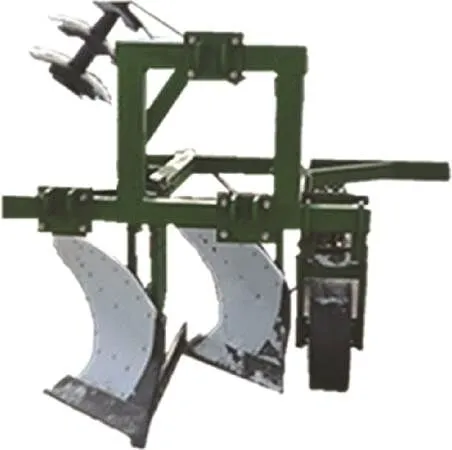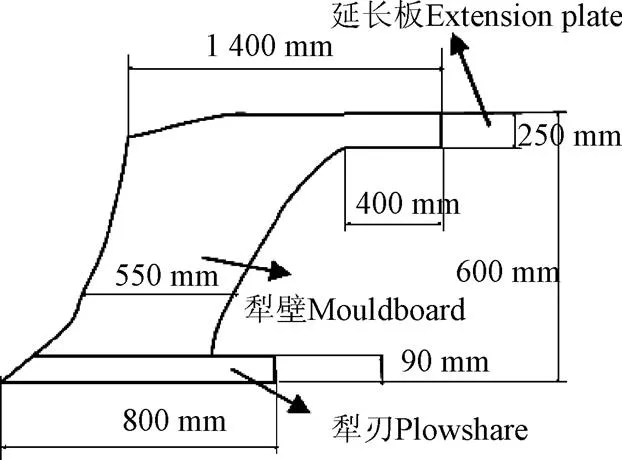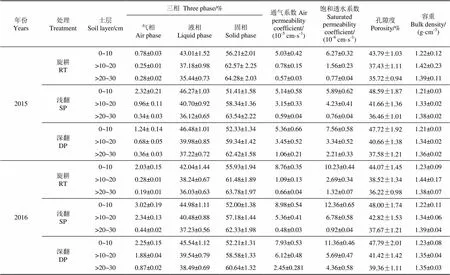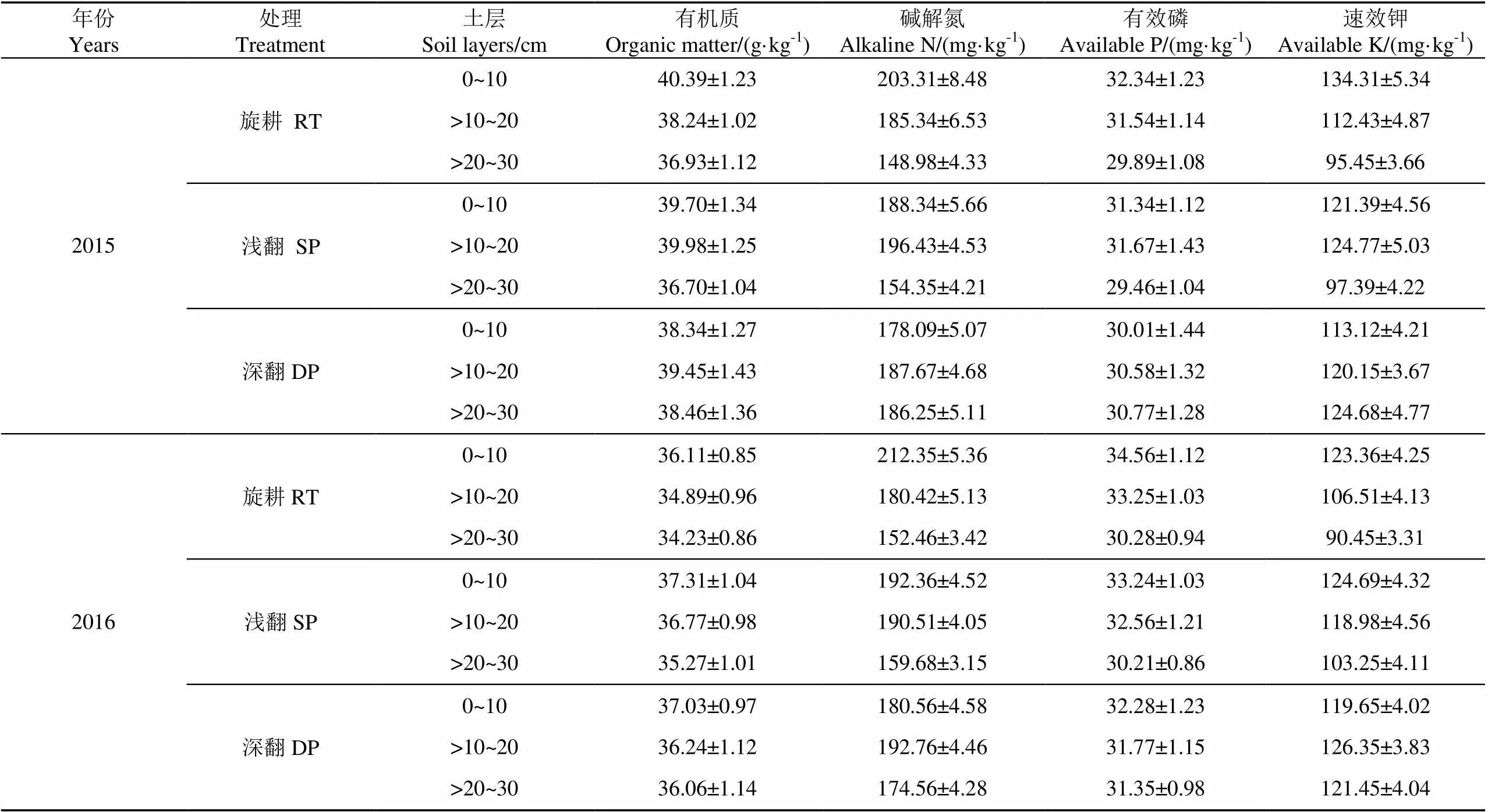黑土稻田连续深耕改善土壤理化性质提高水稻产量大田试验
王秋菊,高中超,张劲松,常本超,姜 辉,孙 兵,郭中原,贾会彬,焦 峰,刘 峰
黑土稻田连续深耕改善土壤理化性质提高水稻产量大田试验
王秋菊1,高中超1,张劲松1,常本超1,姜 辉2,孙 兵3,郭中原4,贾会彬5,焦 峰6,刘 峰2※
(1. 黑龙江省农业科学院土壤肥料与环境资源研究所,哈尔滨 150086; 2. 黑龙江省农业科学院科研处,哈尔滨 150086;3. 黑龙江省农业科学院耕作栽培研究所,哈尔滨 150086; 4. 黑龙江省庆安水利实验站,庆安 152400;5. 黑龙江省农业科学院佳木斯分院,佳木斯 154000; 6. 黑龙江八一农垦大学,大庆163319)
为了明确深耕对水田土壤理化性质及水稻产量影响,该文在黑土型水稻土上开展深耕研究,应用自主研发的水田深翻犁,开展深翻、浅翻与旋耕大区对比研究。结果表明:浅翻和深翻可以降低土壤固相比率和容重,与旋耕相比,土壤固相比率降低幅度分别为0.74%~4.80%和1.86%~3.90%;>10~20 cm土层土壤容重分别下降0.09 g/cm3和0.08 g/cm3,>20~30 cm土层深翻处理土壤容重比旋耕下降0.03 g/cm3;>10~20 cm土层土壤的通气系数和饱和透水系数浅翻处理比旋耕分别提高4.04倍和2.71倍,深翻提高4.42倍和2.14倍;>20~30 cm深翻比旋耕提高1.86倍和2.87倍,2年趋势一致;深翻可使土壤养分指标在各层趋于平均化;深耕可促进水稻根系生长,根系的生长量与根长增加幅度为6.53%~16.33%和10.81%~21.62%,深翻好于浅翻;深耕提高水稻产量,2015年浅翻和深翻处理水稻实测产量分别比旋耕增产6.91%和9.81%,2016年增产6.59%和7.84%,2年增产趋势一致。
土壤;耕作;有机质;深耕;理化性质;根系;养分累积;产量
0 引 言
黑龙江省是中国种稻大省,水稻种植面积在384.3万hm2[1]。水田整地长期以旋耕或浅翻整地模式为主,旋耕深一般8~10 cm,浅翻为12~13 cm[2-4]。长期浅耕存在问题:一是使犁底层上移,导致有效耕层变薄,导致耕层变浅,犁底层位置上升,根系有效生存空间缩小,根系无法吸收到深层土壤的养分,单位面积土壤养分供给量下降[5],水稻生产不得不依靠大量施用化学肥料来维系高产、稳产。二是浅耕易造成水稻生育后期倒伏[6-7],由于根系受犁底层阻碍,导致根系不能垂直生长,只能水平延伸,导致根系固持能力下降。朱德峰等[8]曾研究,水稻根系向下延伸的深度与根系固持土壤能力密切相关,深层土壤中根系越多,其固定土壤能力越强,抗倒伏能力越强;浅耕使单位面积土壤养分供给量下降,为满足作物生长,不得不大量施用化肥,化肥过量造成水稻贪青晚熟,也是导致水稻倒伏减产的重要原因[9]。三是犁底层阻碍土壤通气性和透水性,土壤上下土层空气不流通,土壤长期处于还原状态,易形成铁、锰等还原性物质和H2S还原性气体,导致水稻根系中毒而减产[10-12]。在黑龙江地区水田生产调查也表明,高产田土壤耕层厚度一般15~17 cm,犁底层厚度7~8 cm,中产田一般12~15 cm,犁底层厚度一般8~10 cm,低产田一般8~10 cm,犁底层厚度12 cm以上;洪河农场通过多年生产实践得出深耕20 cm比深耕8~10 cm增产10%的结论。近年来,国内外在水稻耕作方面研究比较少,多集中在水稻传统耕作和保护性耕作方面以及机械的研发[13-14]。国内研究主要集中在中国南部和中部水田土壤,主要研究不同耕作方式、或耕作方式与肥料配施对温室气体排放及土壤有机碳的影响[15-17],国外也主要集中在保护性耕作对土壤有机碳和甲烷等温室气体排放的研究[18],对深耕方面研究缺乏。本文在此前提下,应用自主研发的深耕犁在黑土型水稻土上开展水田深耕试验,明确深耕对稻田土壤理化性质及水稻生育、产量影响,为构建合理层提供理论依据和技术支撑。
1 材料与方法
1.1 试验地点
试验地点设在黑龙江省庆安县水利实验站水田试验区(东经127°47′,北纬47°15′),年平均降雨量500 mm,有效活动积温2 550 ℃。
供试土壤为黑土型水稻土,种植水稻时间20 a以上,整地方式长期连续多年采用旋耕模式,旋耕深度8~10 cm。土壤耕层厚度11.3 cm,犁底层厚度10.5 cm。土壤基本性质见表1。

表1 供试土壤基本特性Table 1 Basic characteristics of tested soil
注:pH为水浸;土壤质地划分按照国际分类法。
Note: pH value was derived from water leaching; soil texture divided according to international classification.
1.2 试验设计
试验采用大区对比方法,设置3个处理:分别为旋耕处理、浅翻处理和深翻处理。试验始于2014年秋季,水稻收获后进行机械耕作处理,2015年秋在同一试验区进行相同耕作模式处理。各处理方法如下:
1)旋耕处理:于水稻秋季收获后,采用旋耕机(山东潍坊象力机械有限公司生产,型号:GAN200)进行旋耕,耕深8~10 cm,然后待第2年春季水田直接入水泡田,进行机械水整地;
2)浅翻处理:于水稻秋季收获后,采用自主研发的水田深耕犁进行翻耕处理,耕深13~15 cm,然后于第2年春季水田入水前再用旋耕犁旋耕1遍后,入水泡田机械水整地;
3)深翻处理:与浅翻处理所用机械及方法一致,耕深为22~25 cm。深耕犁结构如图1,犁头尺寸列于图2。图3为各处理田间作业场景及机械作业后地表状况。

图1 水田深耕犁

图2 犁头结构

a. 旋耕a. Rotary tillageb. 浅翻b. Shallow ploughc. 深翻c. Deep plough
试验采用大田对比法,每个处理区长40 m,宽30 m,面积1 200 m2。各处理2年施肥一致,施肥种类分别为尿素(N 46%)、二铵(N 16%,P2O546%)、硫酸钾(K2O 50%);施用量按照纯N、P2O5、K2O计算,分别为150、70、75 kg/hm2;施用方法:N按照基肥、返青肥、穗肥(施用比例为4:3:3)施肥,K按基肥、穗肥(施用比例为3:2)施肥,P肥作为基肥一次性施入;基肥在春季水田水整地时施入,全层施肥,追肥分别在返青期、孕穗期叶面喷施,K肥追肥时期与水稻第2次追施N肥时一致,K肥和N肥混合后叶面喷施。水田灌溉管理模式为浅-湿-干间歇灌溉模式,年际间一致。供试水稻品种为龙庆稻3号。插秧时期,2015年为5月15日,2016年为5月22日。
1.3 调查项目与方法
土壤取样方法:于2015年秋季在每个处理的纵向中心处,横向中间处各挖一个60 cm×60 cm×60 cm土壤剖面,用容积100 cm3的环刀分层取原状土样和化学分析样品,取样层次分别为0~10 cm、>10~20 cm、>20~30 cm土层,取3次平行样,取的环刀用胶带密封后带回实验室备用。考虑到耕层土壤的不均一性,化学样品0~10 cm和10~20 cm土层土壤每个处理按S形取样5点,混合后,按对角线四分法留500 g左右土样带回实验室备用。
化学指标分析方法:土壤pH值采用美国产原位土壤pH计测定,测定位置分别为5、15、25 cm,每层测5点,取平均值;土壤碱解氮采用扩散吸收法测定;土壤速效磷含量测定采用碳酸氢钠提取法测定[19];速效钾含量测定采用盐酸浸提-AAS法测定;土壤有机质采用重铬酸钾外加热法测定;阳离子代换量采用乙酸胺交换法[20]。
物理指标测定方法:用土壤DIK-1130土壤三相测定仪测定土壤固相、液相和气相;土壤容重采用环刀法测定;土壤含水率采用烘干法测定;土壤饱和导水率采用DIK-4012土壤透水仪测定;土壤通气系数采用采用DIK-5001土壤通气仪测定[21];土壤质地组成采用MS-2000激光粒度仪测定,参照杨金玲等[22]校正系数进行土壤粒级分级的校正。
植株养分测定:于水稻分蘖初期、分蘖盛期、拔节期、抽穗期、灌浆期和成熟期每个处理取有代表性植株10株,带回实验室,烘干、粉碎后待测。植株全氮采用凯氏定氮法,全磷采用钼锑抗比色法,全钾采用火焰光度计法测定[20]。
水稻根系活力的测定:采用根系伤流法测定[23],在水稻分蘖末期,选取代表性植株5株,在距离地面留茬5 cm处剪去茎秆,所留根茬用脱脂棉覆盖,然后用塑封膜密封(图4),经过24 h后取下脱脂棉,称重,记下脱脂棉增加的重量,即为根系伤流量,伤流量的多少反映根系的活力。
作物产量调查:每个处理取10株,室内考种调查产量性状;产量田间实测,每个处理采用久保田收割机全区直接收获。
1.4 数据分析
用Microsoft Excel及 DPS 6.85处理数据。
2 结果与分析
2.1 对土壤物理性质的影响
从表2看出,土壤固相比率在0~30 cm土层,浅翻和深翻处理比旋耕处理分别降低0.74%~4.80%和1.86%~3.90%;土壤通气系数和饱和透水系数均呈增加趋势,浅翻处理10~20 cm土层土壤的通气系数和饱和透水系数比旋耕分别提高4.04倍和2.71倍,深翻处理比旋耕分别提高4.42倍和2.14倍,深翻处理20~30 cm土层土壤分别比旋耕提高1.86倍和2.87倍;浅翻和深翻处理土壤孔隙度与旋耕相比均有增加趋势,0~30 cm土层浅翻增加幅度为0.44%~4.80%,深翻增加幅度为1.86%~3.93%;与旋耕处理相比,土壤容重随土层的加深下降明显,浅翻处理>10~20 cm土层比旋耕分别下降0.09 g/cm3,深翻处理下降0.08 g/cm3,>20~30 cm土层深翻处理土壤容重比旋耕下降0.03 g/cm3。2016年不同处理土壤各项物理指标变化趋势与2015年基本一致。

表2 深耕对土壤物理性质的影响
注:RT、SP、DP分别指旋耕、浅翻和深翻。
Note: RT, SP and DP refer to rotary tillage shallow plough and deep plough, respectly.
2.2 对土壤化学性质的影响
从表3看出,2015年旋耕处理土壤有机质、碱解氮、有效磷和速效钾含量从表层到深层呈逐渐下降趋势,由于黑土是一类黑土层厚的土壤,各土层土壤养分差异并不很明显[24],翻耕后不会导致耕层土壤养分明显下降,深层土壤养分含量与旋耕相比有增加趋势。浅翻处理在>10~20 cm土层土壤的有机质、碱解氮、有效磷和速效钾含量稍高于旋耕处理,深翻处理表现在>10~30 cm土层土壤有机质、碱解氮、有效磷和速效钾含量高于旋耕处理。2016年各处理土壤养分变化趋势与2015年趋势一致。深翻处理使黑土型水稻土各层土壤养分趋于平均化,利于水稻各生育时期植株对土壤养分的吸收。

表3 深耕对土壤化学性质的影响
2.3 对水稻氮、磷、钾素吸收的影响
从图5看出,水稻籽实氮素含量深翻>浅翻>旋耕处理,说明深翻利于植株对深层土壤氮素的吸收;水稻籽实磷素和钾素含量浅翻>深翻>旋耕。
2.4 对水稻根系活力及生长量的影响
水稻伤流量大小直接反映水稻主动吸收养分能力,是根系活力的重要表征指标。从图6看出,深翻处理和浅翻处理水稻伤流量分别比旋耕增加12.17%和6.09%。从表4看出,浅翻和深翻处理水稻根系生长量和根系垂直长度均高于旋耕处理,浅翻处理根系干物质质量和根系长度比旋耕处理增加6.53%和10.81%,深翻处理比旋耕增加16.33%和21.62%,图7是各处理水稻根系图片。
2.5 对水稻产量的影响
从表5看出,浅翻和深翻处理可以提高水稻有效穗数和穗粒数,降低籽粒空瘪率,提高产量。2015年浅翻和深翻处理水稻实测产量分别比旋耕处理增产6.91%和9.81%,2016年增产6.59%和7.84%。2016年浅翻和深翻处理比旋耕增产幅度差异没有第2015年明显,但2年试验增产趋势一致,说明加深耕层对于水稻增产有一定意义。

表4 深耕对根系生长影响

表5 深耕对水稻产量影响
3 讨 论
日本学者采用深耕技术改良老朽化水田收到很好增产效果[25];但在沙质土上深耕可能会造成漏水、漏肥[24,26]。黑龙江省水田主要分布在低平原地区,土壤通透性差,排水不良,氧化还原电位低,水稻根系易受到还原性物质危害[27-28]。冯国禄等[29]认为,深耕是降低还原气体含量的有效措施。另一方面长期旋耕整地的水田,耕层厚度约为10~12 cm,影响水稻根系生长,易发生倒伏[8],深耕扩大根系生活领域,利于根系吸收深层土壤养分[30],所以适当深耕有利于水稻养分累积。本研究证明,水稻对养分累积量,耕深13~15 cm的浅翻处理高于耕深22~25 cm的深翻处理,比较旋耕、浅翻、深翻耕层养分看出,浅翻作业后,由于垡块之间产生较大空隙,耕层土壤迅速脱水干燥,有利于土壤产生“干土效应”,促进耕层养分矿化分解,土壤有效养分高于其他2处理,这对水稻养分吸收和积累作用很大。深翻区由于部分下层土翻到地表,导致耕层土壤养分含量降低,不利于水稻生育。尽管深耕处理下层土壤有效养分较高,但下土层水稻根系少,养分吸收量也较少。
从产量上看,连续耕翻2年,深翻增产7.84%~9.81%,浅翻增产6.91%~6.59%,二者产量差异不明显。综合考虑到深翻消耗动力大,不仅成本高,易造成耕层养分下降,还不利于插秧和收获等田间作业,易导致机械水整地或插秧陷车等现象,作业经济效益并不高。所以,不建议连续深翻,在黑土型水田耕翻整地耕深应以15 cm为宜。
4 结 论
1)深耕降低土壤固相比率和容重,体高土壤孔隙度。在0~30 cm土层,浅翻和深翻处理土壤固相比率比旋耕分别降低0.74%~4.80%和1.86%~3.90%;>10~20 cm土层土壤容重浅翻和深翻处理比旋耕分别下降0.09和0.08 g/cm3,>20~30 cm土层深翻处理土壤容重比旋耕下降0.03 g/cm3;浅翻和深翻处理0~30 cm土层土壤孔隙度与旋耕相比增加幅度分别为0.44%~4.80%和1.86%~3.93%;2年趋势一致。
2)深耕提高土壤通气系数和饱和透水系数。>10~20 cm土层土壤的通气系数和饱和透水系数浅翻处理比旋耕分别提高4.04倍和2.71倍,深翻提高4.42倍和2.14倍;>20~30 cm深翻比旋耕提高1.86倍和2.87倍。
3)深耕可使土壤有机质、碱解氮、有效磷和速效钾养分指标在各层趋于平均化,上下土层养分差异不明显。
4)深耕可促进水稻根系生长及植株养分累积量,提高水稻产量,2015年浅翻和深翻处理水稻实测产量分别比旋耕增产6.91%和9.81%,2016年增产6.59%和7.84%,2年增产趋势一致,但第2年深翻与浅翻相比增产幅度差异不大。
[1] 中华人民共和国国家统计局. 中国统计年鉴[M]. 北京:中国统计出版社,2016.
[2] 麻海春,魏延雪. 寒地水田耕作方式探讨[J]. 农民致富之友,2016(6):144-145.
[3] 杨正梅.我国水田保护性耕作技术研究进展[J]. 安徽农业科学,2007,35(25):7797-7798.
Yang Zhengmei. Research progress on paddy-field conservation tillage technology in China[J]. Journal of Anhui Agri. Sci. 2007, 35(25): 7797-7798. (in Chinese with English abstract)
[4] 董力洪,药林桃,曹晓琳,等. 南方双季稻区水田机械化保护性耕作试验[J]. 广东农业科学,2015,42(24):17-21.
Dong Lihong, Yao Lintao, Cao Xiaolin, et al. Experimental study on paddy field mechanized conservation tillage in double-cropping areas in southern China[J]. Guangdong Agricultural Sciences, 2015, 42(24): 17-21. (in Chinese with English abstract)
[5] 花伟东,郭亚芬,张忠学. 坡耕地局部打破犁底层对水分入渗的影响[J]. 水土保持学报,2008,22(5):213-216.
Hua Weidong, Guo Yafen, Zhang Zhongxue. Influence of plough pan on broke partially slope farmland to moisture content infiltration[J]. Journal of Soil and Water Conservation, 2008, 22(5): 213-216. (in Chinese with English abstract)
[6] 宋日,吴春胜,牟金明,等. 打破犁底层对玉米根系生长发育的影响[J]. 耕作与栽培,2000(5):6-8.
Song Ri, Wu Chunsheng, Mu Jinming, et al. Effects on maize root growth and development after broken plough pan[J]. Tillage and Cultivation, 2000(5): 6-8. (in Chinese with English abstract)
[7] Arima S, Saisho K, Harada J. Morphological analysis of the rice root system based on root diameter[J]. Japanese Journal of Crop Science, 2001(70): 408-417.
[8] 朱德峰,林贤青,曹卫星. 水稻深层根系对生长和产量的影响[J]. 中国农业科学,2001,34(4):429-432.
Zhu Defeng, Lin Xianqing, Cao Weixing. Effects of deep roots on growth and yield in two rice varieties[J]. Scientia Agricultura Sinica, 2001, 34(4): 429-432. (in Chinese with English abstract)
[9] 董桂春,王余龙,吴华,等. 水稻主要根系性状对施氮时期反应的品种间差异[J]. 作物学报,2003,29(6):871-877.
Dong Guichun, Wang Yulong, Wu Hua, et al. Varietal differences in response of main root traits to nitrogen application time in rice (Oryza sativa L.)[J]. Acta Agronomica Sinica, 2003, 29(6): 871-877. (in Chinese with English abstract)
[10] 杨建昌. 水稻根系形态生理与产量、品质形成及养分吸收利用的关系[J]. 中国农业科学,2011,44(1):36-46.
Yang Jianchang. Relationships of rice root morphology and physiology with the formation of grain yield and quality and the nutrient absorption and utilization[J]. Scientia Agricultura Sinica, 2011, 44(1): 36-46. (in Chinese with English abstract)
[11] 周祖英. 水稻根系的生长特性与水田土壤[J]. 福建农业科技,1979(6):1-5.
Zhou Zuying. Growth characteristics of rice root system and paddy field soil[J]. Fujian Agricultural Science and Technology, 1979(6): 1-5. (in Chinese with English abstract)
[12] 郑丽萍,徐海芳. 犁底层土壤入渗参数的空间变异性[J].地下水,2006,28(5):55-56.
Deng Liping, Xu Haifang. Spatial variability of the bottom of ploughed stratum[J]. Ground Water, 2006, 28(5): 55-56. (in Chinese with English abstract)
[13] 周勇,许绮川,夏俊芳,等. 南方多熟制稻区水田耕作新技术新装备研究[J]. 安徽农业科学,2011,39(19):11922-11923,11927.
Zhou Yong, Xu Qichuan, Xia Junfang, et al. Study on new techniques and equipments for paddy field cultivation in multi-cropping rice region in southern China[J]. Journal of Anhui Agri. Sci., 2011, 39(19): 11922-11923, 11927. (in Chinese with English abstract)
[14] Sang Yoon Kim, Jessie Gutierrez, Pil Joo Kim. Unexpected stimulation of CH4emissions under continuous no-tillage system in mono-rice paddy soils during cultivation[J]. Geoderma, 2016, 267: 34-40.
[15] Hao Qingju, Cheng Binghong, Jiang Changsheng. Long-term tillage effects on soil organic carbon and dissolved organic carbon in a purple paddy soil of Southwest China[J]. Acta Ecologica Sinica, 2013, 33: 260-265.
[16] Chen Zhongdu, Shadrack Batsile Dikgwatlhe, Xue Jianfu, et al. Tillage impacts on net carbon flux in paddy soil of the Southern China[J]. Journal of Cleaner Production, 2015, 103: 70-76.
[17] Zhang Z S, Chen J, Liu T Q, et al. Effects of nitrogen fertilizer
sources and tillage practices on greenhouse gas emissions in paddy fields of central China[J]. Atmospheric Environment, 2016, 144: 274-281.
[18] Sang Yoon Kim, Jessie Gutierrez, Pil Joo Kim. Unexpected stimulation of CH4emissions under continuous no-tillage system in mono-rice paddy soils during cultivation[J]. Geoderma, 2016, 267: 34-40.
[19] 鲍士旦. 土壤农化分析[M]. 北京:中国农业出版社,2005:30-165.
[20] 鲁如坤. 土壤农业化学分析[M]. 北京:中国农业科技出版社,1999.
[21] 翁德衡. 土壤物理性测定法[M]. 重庆:科学技术文献出版社重庆分社,1979.
[22] 杨金玲,张甘霖,李德成,等. 激光法与湿筛-吸管法测定土壤颗粒组成的转换及质地的确定[J]. 土壤学报,2009,46(5):772-780.
Yang Jinling, Zhang Ganlin, Li Decheng, et al. Relationships of soil particle size distribution between sieve-pipette and laser diffraction methods[J]. Acta Pedologica Sinica, 2009, 46(5): 772-780. (in Chinese with English abstract)
[23] 郭士伟,夏士健,朱虹霞,等. 水稻根系活力测定方法及超级稻两优培九生育后期根系活力研究[J]. 土壤,2012,44(2):308-311.
Guo Shiwei, Xia Shijian, Zhu Hongxia, et al. Factors influencing collecting amount of rice roots bleeding and investigation on roots vigor after heading[J]. Soils, 2012, 44(2): 308-311. (in Chinese with English abstract)
[24] 黑龙江省土地管理局,黑龙江省土壤普查办公室. 黑龙江土壤[M]. 北京:农业出版社,1992.
[25] 川口桂三郎. 水田土壤学[M]. 北京:农业出版社,1985.
[26] 中国科学院南京土壤研究所. 中国土壤[M]. 北京:科学出版社,1980.
[27] Zhang Z J, Wang Z D, Yao J X, et al. Effects of hydrological practices on nutrients export from paddy field: A review[J]. Ecology and Enveronment, 2007, 16(6): 1789-1794.
[28] Yin G X, Zhang Z Y, Guo X P, et al. Experimental study on effect of controlled drainage from ground surface on concentration and discharge of nitrogen[J]. Journal of Hohai University: Natural Sciences, 2006, 34(1): 21-24.
[29] 冯国禄,杨仁斌. 不同耕作模式下稻田水中氮磷动态特征及减排潜力[J]. 生态学报,2011,31(15):4235-4243.
Feng Guolu, Yang Renbin. Dynamic changes in nitrogen and phosphorus concentrations and emission-reduction potentials in paddy field water under different tillage models[J]. Acta Ecologica Sinica, 2011, 31(15): 4235-4243. (in Chinese with English abstract)
[30] 徐国伟,王贺正,翟志华,等. 不同水氮耦合对水稻根系形态生理、产量与氮素利用的影响[J]. 农业工程学报,2015,31(10):132-141. Xu Guowei, Wang Hezheng, Zhai Zhihua, et al. Effect of water and nitrogen coupling on root morphology and physiology, yield and nutrition utilization for rice[J]. Transactions of the Chinese Society of Agricultural Engineering (Transactions of the CSAE), 2015, 31(10): 132-141. (in Chinese with English abstract)
Black-soil paddy field experiment on improving soil physical and chemical properties and increasing rice yield by continuous deep ploughing
Wang Qiuju1, Gao Zhongchao1, Zhang Jinsong1, Chang Benchao1, Jiang Hui2, Sun Bing3, Guo Zhongyuan4, Jia Huibin5, Jiao Feng6, Liu Feng2※
(1.150086; 2.,150086,; 3.,,150086,; 4.152400,; 5.154007; 6.,163319,)
Rice is cultivated in large area in Heilongjiang Province. The area of rice cultivation in Heilongjiang is about 100 thousand hectares. For a long time, rotary or shallow ploughing is the main tillage mode of paddy soil. Rotary tillage depth is usually 8-10 cm, and shallow ploughing is 12-13 cm. Long term shallow ploughing has the following problems. First, it makes plough pan layer move upward, which leads to the shallower tillage layer and the rise of the plow bottom. With the reduction of effective space for roots growth, roots cannot absorb nutrients from deep soil and the soil nutrient supply per unit area will decrease. Second, it easily leads to rice lodging in late growth stage due to the shallow rooting zone. When the roots are hindered by the plough pan layer, they cannot grow vertically and only extend horizontally, which results in a decrease in the ability to support stems. The more roots in the deep soil, the stronger the ability of roots to fix the soil, and the stronger lodging resistance. Shallow ploughing leads to a decrease in the soil nutrient supply per unit area. In order to meet the growth of crops, a large amount of fertilizers have to be applied, especially nitrogen, which can cause late maturing rice, lodging and losses in yield. Third, soil aeration and water permeability are impeded by the plow bottom, the air in the upper and lower soil layers is not in circulation. As long as the soil is in the reduction state, it is easy to form reduced iron, manganese as well as reduced gases such as H2S, which results in rice roots poisoning and a reduction of yield. The results of the survey for rice cultivation in Heilongjiang area showed that the topsoil thickness of high-yield cropland soil is generally 15-17 cm, and the plough layer thickness is 7-8 cm. the medium-yield cropland soil is generally 12-15 cm and 8-10 cm, and low-yield is 8-10 cm and greater than 8-10 cm, respectively. In Honghe farm, long term production practice concluded that the yield of 20 cm deep ploughing was 10% higher than that of 8-10 cm. In order to clarify the effects of deep ploughing on soil physical and chemical properties and rice yield, in this paper, we carried out the research of large area contrast of deep tillage, shallow tillage and rotary tillage by use of the independent developed deep plough of paddy field. The results showed that shallow and deep ploughing can reduce soil solid ratio and bulk density. The soil solid phase ratio was 0.74%-4.80% and 1.86%-3.90% lower than rotary tillage respectively. The soil bulk density respectively decreased by 0.09 g/cm3and 0.08 g/cm3in the 10-20 cm soil layer. The soil bulk density of deep ploughing was decreased by 0.03 g/cm3than that of rotary tillage in the 20-30 cm soil layer. Compared with rotary tillage, the soil permeability coefficient and saturated permeability coefficient of shallow ploughing were increased by 4.04 and 2.71 times in the 10-20 cm soil layer, respectively, those of deep ploughing were 4.42 and 2.14 times, and those of deep ploughing were 1.86 and 2.87 times in the 20-30 cm soil layer. In two years, the change trend of soil aeration coefficient and saturated permeability coefficient was consistent. Deep ploughing can promote the growth of rice roots. The increase of root growth amount and length was 6.53%-16.33% and 10.81%-21.62%, respectively, and deep ploughing is better than shallow. Deep ploughing increases the yield of rice. In 2015, shallow and deep ploughing in rice yield increased by 6.91% and 9.81%, respectively compared with rotary tillage, and by 6.59% and 7.84% in 2016. The trend of increasing yield was consistent in two years.
soil; cultivation; organic matter; deep ploughing; physical and chemical properties; root; nutrient accumulation; yield
10.11975/j.issn.1002-6819.2017.09.016
S152
A
1002-6819(2017)-09-0126-07
2016-11-28
2017-02-24
农业部公益性行业专项(201503118-04);省自然科学基金(D2015005)
王秋菊,女,黑龙江省依兰人,博士,副研究员,从事土壤改良研究。哈尔滨 黑龙江省农业科学院土壤肥料与环境资源研究所,150086。Email:bqjwang@126.com.
刘 峰,男,黑龙江集贤人,研究员,从事土壤改良研究。哈尔滨 黑龙江省农业科学院科研处,150086。Email:liufengjms@163.com.
王秋菊,高中超,张劲松,常本超,姜 辉,孙 兵,郭中原,贾会彬,焦 峰,刘 峰. 黑土稻田连续深耕改善土壤理化性质提高水稻产量大田试验[J]. 农业工程学报,2017,33(9):126-132. doi:10.11975/j.issn.1002-6819.2017.09.016 http://www.tcsae.org
Wang Qiuju, Gao Zhongchao, Zhang Jinsong, Chang Benchao, Jiang Hui, Sun Bing, Guo Zhongyuan, Jia Huibin, Jiao Feng, Liu Feng. Black-soil paddy field experiment on improving soil physical and chemical properties and increasing rice yield by continuous deep ploughing[J]. Transactions of the Chinese Society of Agricultural Engineering (Transactions of the CSAE), 2017, 33(9): 126-132. (in Chinese with English abstract) doi:10.11975/j.issn.1002-6819.2017.09.016 http://www.tcsae.org

